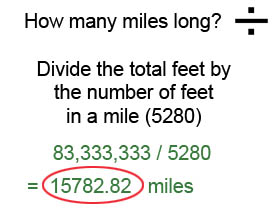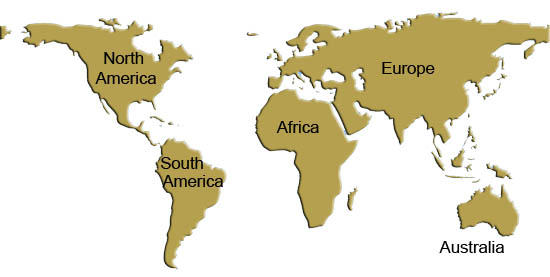Scale Activity Part 2
Now that we know how large a one inch line becomes when we magnify it one hundred thousand times (100,000 X), what would happen if we magnify the same line a billion times (1,000,000,000 X)?
| Continent | Area (miles²) | Area (kilometers²) |
| Africa | 11,725,922 | 30,370,000 |
| Australia | 2,934,376 | 7,600,000 |
| Europe | 3,930,520 | 10,180,000 |
| North America | 9,455,642 | 24,490,000 |
| South America | 6,888,062 | 17,840,000 |
Here is an activity for you.
If you have followed the two mathematic activities it becomes clear that changing the size of things can have a very big impact. However, the biggest impact is still to be calculated. If the nano world is actually one billion times smaller than a meter, to get an idea of the reverse you need to calculate the size of a one meter line magnified one billion times.
Take a line one meter long by one millimeter wide. Calculate how big this line would be if we magnified it one billion times. Then, answer these questions:
- How many times could the line go back a forth between the Earth and the Moon?
- How many Earths could you cover with the magnified line if were carpet?
Send us your answers and we will let you know how well you have done.
Nanogears image from Wikimedia - Jie Han, Al Globus, Richard Jaffe and Glenn Deardorff
Read more about: Nanoparticles - A Matter of Scale
Bibliographic details:
- Article: Scale Activity Part 2
- Author(s): Dr. Biology
- Publisher: Arizona State University School of Life Sciences Ask A Biologist
- Site name: ASU - Ask A Biologist
- Date published:
- Date accessed:
- Link: https://askabiologist.asu.edu/scale-activity-continued
APA Style
Dr. Biology. (). Scale Activity Part 2. ASU - Ask A Biologist. Retrieved from https://askabiologist.asu.edu/scale-activity-continued
Chicago Manual of Style
Dr. Biology. "Scale Activity Part 2". ASU - Ask A Biologist. . https://askabiologist.asu.edu/scale-activity-continued
Dr. Biology. "Scale Activity Part 2". ASU - Ask A Biologist. . ASU - Ask A Biologist, Web. https://askabiologist.asu.edu/scale-activity-continued
MLA 2017 Style

Be Part of
Ask A Biologist
By volunteering, or simply sending us feedback on the site. Scientists, teachers, writers, illustrators, and translators are all important to the program. If you are interested in helping with the website we have a Volunteers page to get the process started.










